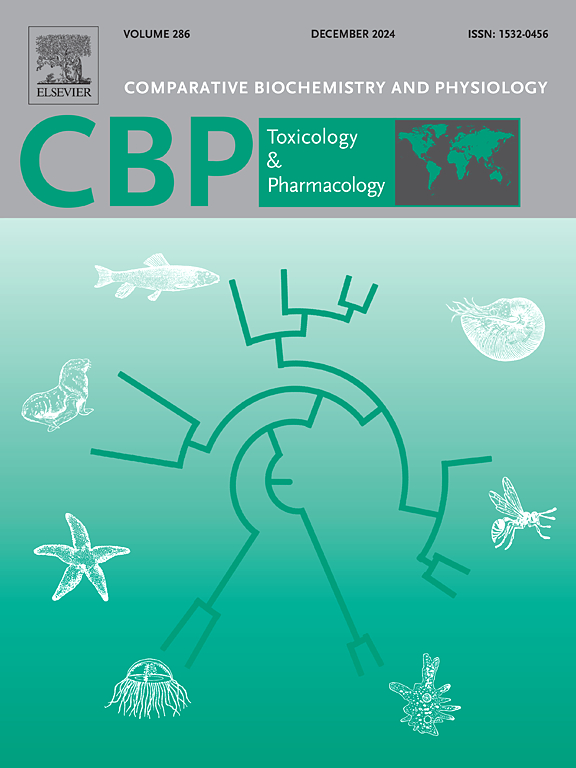Morphological, biochemical, and histological alterations in juvenile giant freshwater prawns (Macrobrachium rosenbergii) exposed to sub-lethal concentrations of 2,4-D dimethylammonium
IF 3.9
3区 环境科学与生态学
Q2 BIOCHEMISTRY & MOLECULAR BIOLOGY
Comparative Biochemistry and Physiology C-toxicology & Pharmacology
Pub Date : 2025-04-23
DOI:10.1016/j.cbpc.2025.110212
引用次数: 0
Abstract
The widespread use of herbicides, such as 2,4-D dimethylammonium, poses significant risks to aquatic ecosystems. This study assessed the toxicological effects of 2,4-D dimethylammonium on juvenile giant freshwater prawns (Macrobrachium rosenbergii) by assessing mortality, total hemocyte count (THC), acetylcholinesterase (AChE) expression, and tissue integrity using optical coherence tomography (OCT) and histological analysis. Prawns were exposed to 0, 250, 300, 350, 400, and 450 μL/L of 2,4-D dimethylammonium for 24, 48, 72, and 96 h, and both LC50 values and sub-lethal effects were examined. Acute toxicity tests revealed dose- and time-dependent mortality, with declining LC50 values over 24 to 96 h. THC levels significantly decreased (p < 0.05) at higher concentrations, with prawns exposed to 450 μL/L showing a 35 % reduction at 96 h. Western blot analysis revealed AChE suppression, with expression becoming faintly detectable at 72 h and undetectable at 96 h at 450 μL/L. OCT analysis showed tissue disorganization, increased light scattering, and structural degradation, aligning with histological findings of hepatopancreas and muscle deterioration in high-exposure groups. The study highlights the environmental risks of 2,4-D dimethylammonium contamination and supports OCT as a non-invasive tool for assessing pesticide toxicity in aquatic organisms.

罗氏沼虾(Macrobrachium rosenbergii)幼虾暴露于亚致死浓度的2,4- d二甲胺后形态学、生化和组织学的改变
2,4- d二甲基铵等除草剂的广泛使用对水生生态系统构成了重大风险。本研究通过光学相干断层扫描(OCT)和组织学分析评估2,4- d二甲胺对罗氏沼虾幼虾(Macrobrachium rosenbergii)的死亡率、总血细胞计数(THC)、乙酰胆碱酯酶(AChE)表达和组织完整性,评估了2,4- d二甲胺对罗氏沼虾幼虾的毒理学影响。分别用0、250、300、350、400和450 μL/L浓度的2,4- d二甲铵对对虾处理24、48、72和96 h,检测LC50值和亚致死效应。急性毒性试验揭示了剂量和时间依赖性死亡率,LC50值在24至96小时内下降。四氢大麻酚水平显著降低(p <;在450 μL/L的浓度下,乙酰胆碱酯酶在96 h时表达量降低35%。Western blot分析显示,乙酰胆碱酯酶在72 h时表达量微弱,在450 μL/L的浓度下表达量在96 h时无法检测到。OCT分析显示组织紊乱,光散射增加,结构退化,与高暴露组肝胰腺和肌肉退化的组织学结果一致。该研究强调了2,4- d二甲胺污染的环境风险,并支持OCT作为评估农药对水生生物毒性的非侵入性工具。
本文章由计算机程序翻译,如有差异,请以英文原文为准。
求助全文
约1分钟内获得全文
求助全文
来源期刊
CiteScore
7.50
自引率
5.10%
发文量
206
审稿时长
30 days
期刊介绍:
Part C: Toxicology and Pharmacology. This journal is concerned with chemical and drug action at different levels of organization, biotransformation of xenobiotics, mechanisms of toxicity, including reactive oxygen species and carcinogenesis, endocrine disruptors, natural products chemistry, and signal transduction with a molecular approach to these fields.

 求助内容:
求助内容: 应助结果提醒方式:
应助结果提醒方式:


